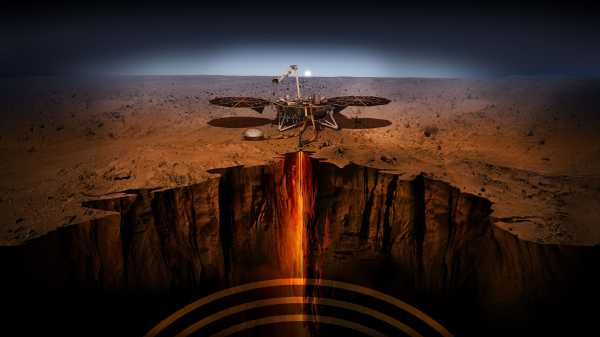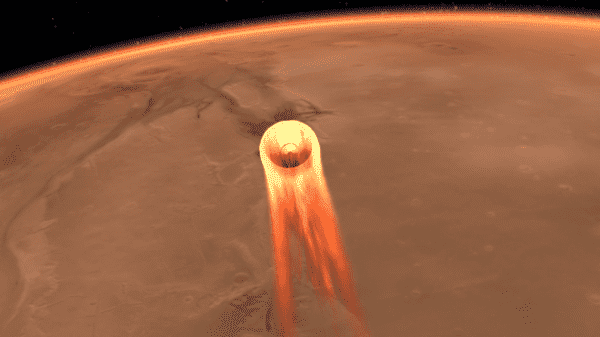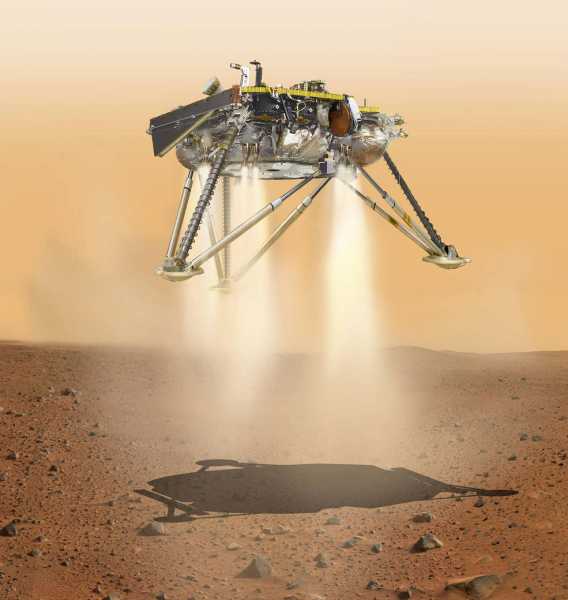
A major feat of interplanetary space travel is about to take place on Monday, November 26. That’s when NASA’s InSight lander is expected to land on Mars and begin its two-year study of our neighboring planet’s core. It will be the first NASA Mars landing since the Curiosity rover touched down in 2012.
The lander is expected to touch Mars around 3 pm Eastern time, and you can watch the live stream in the NASA link below. But because it’s so far away, NASA’s mission scientists at the Jet Propulsion Laboratory in California won’t get to pilot it. Their radio transitions to the lander are delayed by several minutes. Like the Curiosity rover, InSight will have to land itself in only 6.5 minutes.
The live programming from NASA TV will begin at 2 pm Eastern Monday.
Landing a robot spacecraft on Mars isn’t easy
It’s a huge engineering feat to land on Mars, and not just because it’s millions of miles away.
The Red Planet has almost the same gravitational pull as Earth, but unlike Earth, it doesn’t have a thick atmosphere to help slow down spacecraft. InSight will hit the Martian atmosphere traveling at 12,300 mph, and within 6.5 minutes, it will have to slow down to 5 mph in order to land. That’s the challenge.
Here’s how it will meet it.
The landing will happen in a few stages that have all been carefully programmed by NASA scientists. First, InSight detaches from the “cruise stage” of the mission. This is the part of the craft that ferried it from Earth to Mars, and Insight needs to leave it behind in space.
Then Insight will turn so its heat shield is pointed dead-on at the atmosphere, which starts about 70 miles over the surface of the planet.

That heat shield will protect it as it slows down from 12,300 mph to 1,000 mph in just two minutes. Then, 10 miles above the surface, it will jettison the heat shield and deploy a parachute. But the parachute won’t be enough to slow the craft to landing speed.
This is the most harrowing part: InSight has to land itself, and it has to be ready for less than ideal conditions, like a dust storm.
About a mile above Mars, InSight will let go of the parachute and turn on some thrusters. It will have to quickly maneuver to not hit the jettisoned parachute.
Guided by radar, InSight will use the thrusters to slow down to a soft landing. Upon landing, the thrusters must immediately turn off. (If Insight tips over on the surface, there will be no picking it back up.)

InSight is landing on a region of Mars called Elysium Planitia, a large, flat, plain on the equator. The site was chosen, in part, because InSight will be running on solar power, and it needed to be near the equator to get enough sunlight to stay powered for two years.
So what will InSight do there?
Once InSight lands, it stays put. It’s not a rover like Curiosity. And it doesn’t need to move because it’s not there to study the surface of Mars. InSight stands for “Interior Exploration using Seismic Investigations, Geodesy and Heat Transport,” and it’s there to study Mars’s core. It’s basically a robot geologist. Using extremely sensitive instruments, it will literally be able to feel the planet’s seismic activity and temperature, and record, for the first time, “Marsquakes.”
“Each Marsquake would be like a flashbulb that illuminates the structure of the planet’s interior,” NASA explains. “By studying how seismic waves pass through the different layers of the planet (the crust, mantle and core), scientists can deduce the depths of these layers and what they’re made of. In this way, seismology is like taking an X-ray of the interior of Mars.”
This is important to study because scientists want to better understand how rocky planets like Mars, Earth, and Venus form. Underneath the surface of Earth is a molten-hot mantle upon which our landmasses (tectonic plates) float. Plate tectonics are responsible for much of the geologic activity on Earth, generating the energy for earthquakes and volcanoes. But Mars doesn’t have these.
Scientists are curious why a rocky planet like Earth is so geologically dynamic, and why a rocky planet like Mars is so relatively still. Perhaps these insights will lead to a better understanding of why there’s life on Earth but not Mars.
But before all of that, InSight has to land. Godspeed.
Sourse: vox.com






